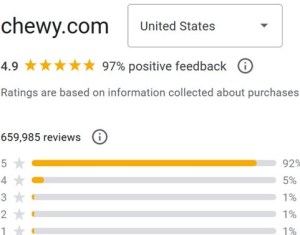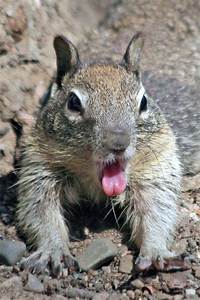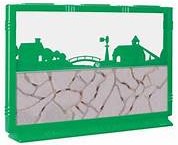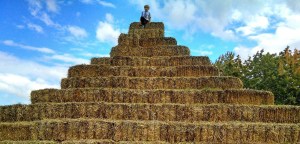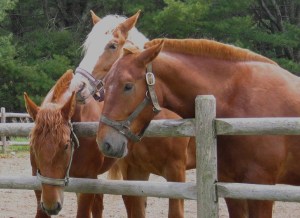Last Sunday, the day before Halloween, our neighborhood hosted a lively parade. Kids of all ages dressed in adorable to “a-horror-full” costumes, to trick-or-treat past each driveway… on horseback. In a bit of a role reversal, we residents walked treats out to the horses and riders (because trust me, a stallion trotting up your front walk is not recommended). Candy for the kids, cookies for the parents who walked beside them, and carrots for the hardworking horses. As you would expect, a steady “clip-clop” filled the air for hours. Yet it could’ve been a lot quieter.
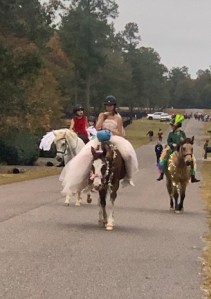 Here’s an idea I never ever would’ve thought of. Take a pair of sneakers, break them down into their component parts, and reassemble them to fit a horse’s hoof. Making a statement of purely fashion (vs. function), Horse Kicks allow your equine to sport two pairs of your favorite New Balance, Adidas, or Nikes. These giant “tennis shoes” are built on top of a pre-made protective boot so they really do support an animal weighing a thousand pounds or more. Order yours today for only $1,200.
Here’s an idea I never ever would’ve thought of. Take a pair of sneakers, break them down into their component parts, and reassemble them to fit a horse’s hoof. Making a statement of purely fashion (vs. function), Horse Kicks allow your equine to sport two pairs of your favorite New Balance, Adidas, or Nikes. These giant “tennis shoes” are built on top of a pre-made protective boot so they really do support an animal weighing a thousand pounds or more. Order yours today for only $1,200.
 Sorry, I’m not buying. I don’t think sneakers are a good look on horses, any more than when paired with formalwear on a human. If a filly could talk, she would say, “Get those ridiculous things off of me!”, even though ladies love shoes. Sneakers are best left to walkers and athletes, while steel horseshoes, as they have for thousands of years, fill a horse’s bill as comfortably as a couple of pairs of flip-flops (er, “clip-clops?”)
Sorry, I’m not buying. I don’t think sneakers are a good look on horses, any more than when paired with formalwear on a human. If a filly could talk, she would say, “Get those ridiculous things off of me!”, even though ladies love shoes. Sneakers are best left to walkers and athletes, while steel horseshoes, as they have for thousands of years, fill a horse’s bill as comfortably as a couple of pairs of flip-flops (er, “clip-clops?”)
I can’t imagine the effort it takes for Horse Kicks to create their shoes (besides the seventeen hours of assembly time) but they don’t work nearly as hard as a traditional horseshoer. That person, a farrier, might as well be an ironworker. Watch one in action sometime as he/she trims a horse’s hoof or hammers the steel shoes to achieve the perfect fit. It’s the kind of backbreaking work that can lead to early retirement.
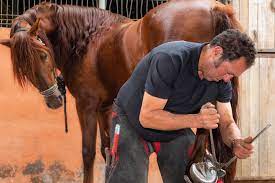 Occasionally a horse throws a shoe, which is probably the origin of horseshoes as a game. The first time I “threw a shoe”- besides getting it nowhere near the stake – I remember thinking, “Man, these are kind of heavy”. (A horse wouldn’t agree.) And weight matters in the game because the shoe needs to fly a long way, like forty feet, for the chance for a “ringer”. Yes, horseshoes is basic (and predates similar games like ring toss, cornhole, and bocce) but it has its finer points. You flip a shoe to determine who goes first. After players throw two shoes each you’ve completed an “inning”. And a “dead ringer” really is a horseshoes term (too complicated to explain here), not just someone who looks like someone else.
Occasionally a horse throws a shoe, which is probably the origin of horseshoes as a game. The first time I “threw a shoe”- besides getting it nowhere near the stake – I remember thinking, “Man, these are kind of heavy”. (A horse wouldn’t agree.) And weight matters in the game because the shoe needs to fly a long way, like forty feet, for the chance for a “ringer”. Yes, horseshoes is basic (and predates similar games like ring toss, cornhole, and bocce) but it has its finer points. You flip a shoe to determine who goes first. After players throw two shoes each you’ve completed an “inning”. And a “dead ringer” really is a horseshoes term (too complicated to explain here), not just someone who looks like someone else.
 [Snack break. Speaking of horseshoes, if you’re looking for “the best darn donuts in Colorado” you should check out Horseshoe Donuts, where we used to live just north of Colorado Springs. You’ll pay upwards of $25/dozen but trust me, these shoes… er, doughnuts are huge and worthy of expensive tastes. Most are shaped like traditional rings but the raised, glazed variety are giant horseshoes.]
[Snack break. Speaking of horseshoes, if you’re looking for “the best darn donuts in Colorado” you should check out Horseshoe Donuts, where we used to live just north of Colorado Springs. You’ll pay upwards of $25/dozen but trust me, these shoes… er, doughnuts are huge and worthy of expensive tastes. Most are shaped like traditional rings but the raised, glazed variety are giant horseshoes.]
 Even if I never buy a pair of Horse Kicks, that doesn’t mean you shouldn’t. You’ll probably see several on display this weekend at the Breeder’s Cup races in Lexington, KY (close to where they’re created). Part of the company’s initiative is to “bring awareness to the Bluegrass State”. And 10% of the proceeds go to central Kentucky charities. All of which makes Horse Kicks a worthy product. Not that I expect to see any in next year’s neigh-h-h-h-borhood trick-or-treat parade. It’ll be, as usual, clip-clops in steel flip-flops.
Even if I never buy a pair of Horse Kicks, that doesn’t mean you shouldn’t. You’ll probably see several on display this weekend at the Breeder’s Cup races in Lexington, KY (close to where they’re created). Part of the company’s initiative is to “bring awareness to the Bluegrass State”. And 10% of the proceeds go to central Kentucky charities. All of which makes Horse Kicks a worthy product. Not that I expect to see any in next year’s neigh-h-h-h-borhood trick-or-treat parade. It’ll be, as usual, clip-clops in steel flip-flops.
Some content sourced from the CNN Style article, “You can now buy $1,200 sneakers — for horses”, and Wikipedia, “the free encyclopedia”.



